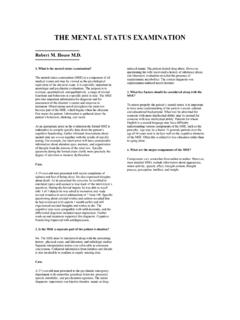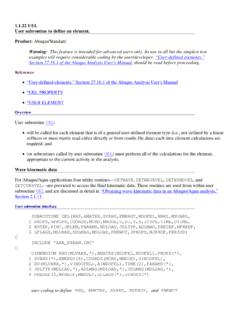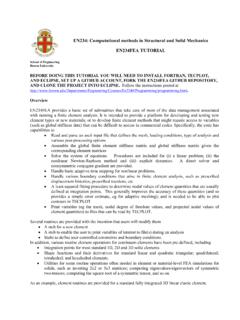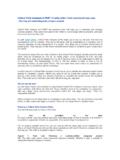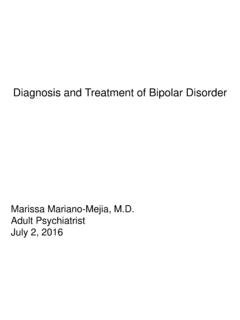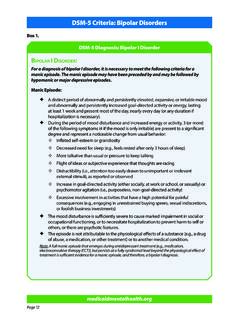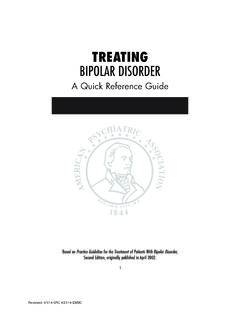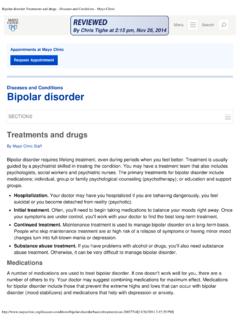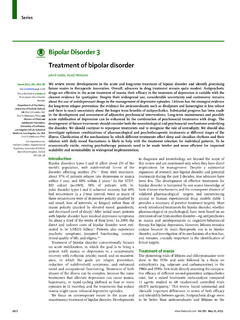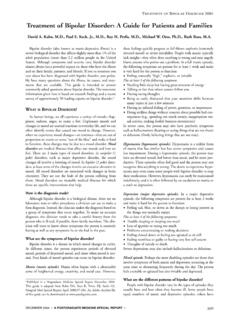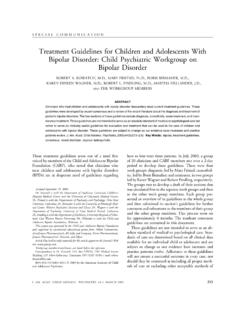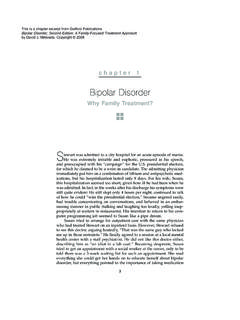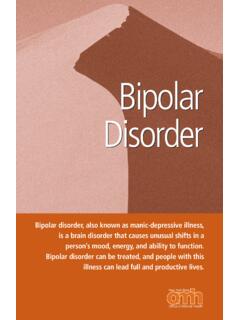Transcription of CHAPTER 14. MOOD DISORDERS 14.8 MOOD DISORDERS: …
1 Page 1 of 49. mood DISORDERS : treatment OF BIPOLAR DISORDERS . Kaplan & Sadock's Comprehensive Textbook of Psychiatry CHAPTER 14. mood DISORDERS . mood DISORDERS : treatment OF BIPOLAR. DISORDERS . ROBERT M. POST, History Impediments to Short- and Long-Term treatment Psychiatric History Time Frame of Education Hospitalization Psychotherapy and Pharmacotherapy Neurotransmitter Theories treatment of Acute Mania Other Theoretical and Mechanistic Considerations Maintenance treatment of Bipolar DISORDERS Potential Correlates of Response to the mood Stabilizers Relative Adverse-Effect Profiles of Lithium and the mood -Stabilizer Anticonvulsants treatment of Breakthrough Depressive Episodes During Lithium and Other mood -Stabilizer Prophylaxis Approaches to Suicidality treatment of Manic Breakthroughs Complex Combination Therapy Sensitization Effects on the mood DISORDERS and Implications for Prophylaxis Future Directions Suggested Cross-References treatment of the
2 mood DISORDERS has reached a new level of sophistication based on a variety of advances. The descriptive and diagnostic aspects of bipolar DISORDERS are now explicitly spelled out, recognizing that it is almost always recurrent with potential for severe morbidity and even mortality. There is increasing recognition that bipolar affective DISORDERS have a prominent genetic component interacting with environmental events, and neurobiological alterations have been documented with biochemical assays and functional brain imaging. Thus, different treatment approaches are recognized as a function of type, severity, and course and as in other branches of medicine require the utmost clinical management skills. Convergent with this increased knowledge about the classification, course, and mechanisms underlying acute episodes and their recurrences is an expanding array of effective psycho- and pharmacotherapeutic modalities and related somatic treatments.
3 Whereas single drugs in one or two classes were available for the treatment of bipolar DISORDERS several decades ago, multiple therapeutic modalities now exist, often including many agents within each class. Thus, the physician must be aware of the nuances in approach to the patient with acute and recurrent mood disorder, so that treatment can be optimized from the outset and the impact of the illness on patients and families minimized. A growing consensus surrounds a series of new treatment principles. Early recognition and intervention in an acute episode may not only save the patient months of pain and suffering, but also may be life saving. More-careful assessment of the efficacy of an agent at early and regular intervals and early revision of the treatment modality if no improvement is shown are recognized guidelines.
4 This is the case for somatic treatments and also for targeted psychotherapeutic approaches using cognitive, 2/11/2004. Page 2 of 49. behavioral, and interpersonal therapies. A substantial body of evidence indicates the efficacy of long-term prophylactic treatments in the management of the recurrent affective DISORDERS . Moreover, earlier institution of long-term prophylaxis is critical to the patient with recurrent mood DISORDERS ; it will affect the morbidity of the illness and likely also its subsequent course and treatment responsiveness. Consensus is growing that a patient with a positive family history and a first episode of bipolar disorder is a candidate for continuation therapy after resolution of that episode and for long-term prophylaxis. These factors have dramatically changed the physician's approach to the patient with an acute episode of a mood disorder.
5 The illness should be approached with the same respect accorded the early diagnosis and treatment of a malignancy. Delayed or inadequate treatment may be associated with considerable acute and long-term morbidity from both the illness and its secondary consequences. Thus, it appears appropriate to reconceptualize the recurrent mood DISORDERS not as illusory mental phenomena that can be modified by the patient's will, but as a serious and potentially life-threatening medical illness that has clearly defined mood , cognitive, motor, somatic, and neurobiological concomitants. Bipolar I disorder occurs in approximately 1 percent of the population, which translates into million people in the United States alone. It is estimated that the average woman with onset of bipolar illness at age 25 will lose 14 years of effective lifetime functioning through her illness.
6 Bipolar II disorder and bipolar disorder not otherwise specified may each account for another 1 percent or more. Fifteen to 20. percent of patients with bipolar illness commit suicide. It is against this backdrop of a recurrent, potentially disabling, medical illness that diagnostic and long-term treatment approaches should be conceptualized. HISTORY. Over the course of this century a revolution has occurred in the treatment of bipolar DISORDERS . In the first half of the century no adequate treatment was available; in the second half, lithium (Eskalith). emerged as a wonder drug for short-term and prophylactic management of the disorder. However, oscillations in the assessment of lithium's safety, efficacy, and utility have persisted. The drug was initially abandoned as unsafe until its concentration could be adequately monitored in blood, which virtually eliminated its most serious and potentially lethal cardiovascular and central nervous system (CNS) toxicities.
7 However, concerns about long-term renal complications have not entirely dissipated after the kidney scare of the 1980s. There is also greater recognition of lithium's efficacy limitations. As with penicillin, these limitations do not imply that lithium no longer works, but that the spectrum of therapeutic efficacy is narrower. More than 50 percent of patients do not show adequate response to lithium even with adjunctive antidepressant and neuroleptic treatment and using conservative criteria for clinical response ( , one episode of illness in a 2-year follow-up). In the middle of the century electroconvulsive therapy (ECT) emerged as the most effective approach to treating acute episodes. Antipsychotics rapidly became a mainstay of treatment for both mania and psychosis.
8 In the 1960s the first-generation monamine oxidase inhibitors (MAOIs) and tricyclic drugs were introduced and widely used in conjunction with lithium. Now, selective serotonin reuptake inhibitors (SSRIs), bupropion (Wellbutrin), venlafaxine (Effexor), mirtazapine (Remeron), and monoamine oxidase (MAO) type A selective modalities are available. Similarly, the phenothiazine, butyrophenone, and thiothixine antipsychotic classes have given way to the serotonin-dopamine antagonists (atypical antipsychotics), such as clozapine (Clozaril) and risperidone (Risperdal);. olanzapine (Zyprexa); quetiapine (Seroquel); and sertindole (Serlect). These new agents include drugs 2/11/2004. Page 3 of 49. with novel structures and mechanisms of action and more benign adverse effect profiles than the original agents.
9 This new range of psychopharmacological agents raises a series of important issues for the clinician, particularly when these agents must be chosen on the basis of an inadequate literature on relative efficacy or clinical and biological markers of responsiveness. There is a consensus that with the exception of ECT, no antidepressant modality is more effective or more rapid in onset than another. Thus, the choice of agents is typically based on their adverse effect profile and clinical lore regarding syndromal selectivity of response. Fortunately, as the limitations of lithium as a mood stabilizer have been increasingly recognized, a variety of other treatment modalities have become available, particularly the anticonvulsants carbamazepine (Tegretol); valproate (Depakene); divalproex (Depakote); as well as the calcium channel inhibitors.
10 Other promising anticonvulsants are being explored as possible third-generation mood stabilizers, including lamotrigine (Lamictal), and possibly gabapentin (Neurontin), and topiramate (Topamax). However, as with targeting therapeutic modalities to specific patients in the depressive DISORDERS , the data are not yet adequate to choose among the accepted mood stabilizers or establish how to use them in combination, which has been increasingly necessary in recurrent bipolar DISORDERS . Thus, the clinician often has to resort to educated guesses and systematic and sequential clinical trials in individual patients to delineate optimal responsivity (Table ). Even with the availability of many new treatments, episodes of illness can often emerge through otherwise partially successful pharmacoprophylaxis and necessitate adjunctive measures.

